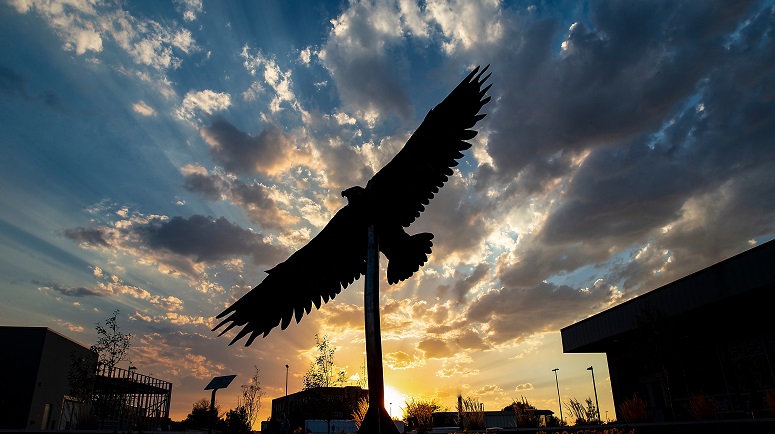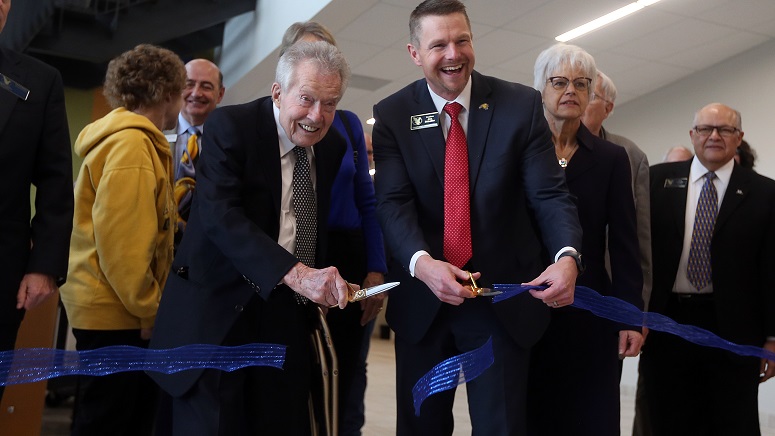Fourteen percent.
That was the graduation rate when Joe Schaffer became president of 5,500-student Laramie County Community College (LCCC) in 2012.
“To say that we were in a tough spot when I arrived would be an understatement,” he says.
Located in the southeast corner of Wyoming, LCCC serves both Laramie and Albany counties, a geographic area of nearly 7,000 square miles—equivalent to three times the size of Delaware. Yet, even though this service area includes the state capital of Cheyenne, its total population is still fewer than 140,000 residents, or about 20 people per square mile.
Its sparsely populated setting means the college lacks the resources of its larger and better-funded peer institutions. But that hasn’t prevented LCCC from making impressive gains under Schaffer’s leadership.
Across a decade of hard work, LCCC has nearly tripled its graduation rate. The college is helping to meet key workforce needs within its communities, and $130 million in capital improvements have made LCCC a place where people want to be.
How has a modest-sized, rural community college been able to make such remarkable progress so quickly?
This article is an excerpt from the new issue of the Community College Journal, published by the American Association of Community Colleges.
Creating better cohesion between the college and its foundation has been a key factor in LCCC’s success. But just as importantly, LCCC has reached out beyond its borders to partner with national organizations such as the Center for Community College Student Engagement (CCCSE), Complete College America, the Aspen Institute, the Community College Research Center at Columbia University, Achieving the Dream and the American Association of Community Colleges (AACC) to improve student outcomes.
“We are blessed to have so many partner organizations who have made it their mission to help colleges big and small, urban and rural, perform better so that our students can succeed in achieving their goals,” Schaffer says. “Had it not been for these organizations, there is simply no way we would have been able to accomplish what we have.”
Schaffer is serving as AACC’s board chair until June 30.
Laying the groundwork
Recognizing that the college needed help, Schaffer reached out to CCCSE shortly after he arrived. “That was the first relationship we developed,” he says. “We wanted to look outside the state to see what we should be doing to be successful.”
CCCSE has identified what it calls 13 “high-impact” practices that research has shown to be effective, and Schaffer’s institution has adopted many of these practices. These include placing more emphasis on new student orientation; offering a student success course that teaches skills such as time management, study skills, and other strategies to help students thrive in college; and implementing more comprehensive student advising that includes academic planning and goal setting.
“We have gone from making advising an option to making it an inescapable part of the student experience,” Schaffer says.
At the same time that, Schaffer was looking to establish a solid foundation for success, he also was aiming to transform the campus environment through an eight-year plan called “Building Forward.” The goal was to invest in campus buildings and infrastructure to make LCCC a place where students and faculty wanted to spend their time.
“Our campus was built by people who knew how to stretch a dollar,” Schaffer says. “It looked very institutional and left a lot to be desired.”
Over the course of the initiative, LCCC was able to raise $130 million for new construction and renovation projects. These included a state-of-the-art residence hall for students to live on campus; a $16 million “Flex Tech” building that had reinvigorated career and technical education at LCCC; and a $30 million, 85,000-square-foot Clay Pathfinder building that serves as the heart of the campus and a starting point for students on their academic journey.
The Flex Tech building is the home to several technical education programs, including the state’s most advanced welding fabrication, laboratory and diesel technology. As its name implies, the building can easily be modified to house additional technical programs as community workforce needs evolve.
In working with CCCSE, Schaffer and his leadership team realized the college made students bounce around campus too much as they navigated their college experience. This process was cumbersome and served to discourage many students from continuing their education. The Clay Pathfinder building addresses this concern by serving as a central hub for all essential services, including admissions, the campus bookstore, student records, financial aid, counseling and academic advising.
“The Clay Pathfinder building became the front door to our campus,” Schaffer says. “It sounds very simple, but it was incredibly confusing for people when they would show up on our campus and not know where to go.”

Fundraising success
While some of the $130 million raised for the Building Forward initiative came from the state legislature, the LCCC Foundation was also instrumental in securing a large share of the money.
Shortly after he joined LCCC, Schaffer approached the foundation’s board of directors and started a conversation about how the college and the foundation could work together more effectively in pursuit of shared goals, says Ron Rabou, an LCCC alumnus who was on the foundation’s board at the time.
“The foundation had always been completely separate from the college. As a result, we were limited in our capabilities,” Rabou says.
In light of this conversation, the foundation added more representation from the campus community to its board of directors. They also engaged their staff to allow for intentional focus on to oversee college providing scholarship supports, as well as someone increaseto direct community outreach initiatives.
Having a community outreach director has led to increased engagement with the community through the cultural and community enrichment and other events that have brought more members of the community to the LCCC campus. This, in turn, has driven greater community engagement and has grown the size of the support base for donations.
Stronger collaboration between the college and the foundation has also meant that fundraising efforts are better aligned with campus needs. Before, the foundation was raising money, but not necessarily around specific needs. Now, there are coordinated campaigns, such as putting the naming rights for new buildings constructed as part of the Building Forward initiative up for bid.
“There is a lot more synergy now,” Rabou says.
Not only was the foundation able to contribute heavily to the Building Forward campaign, but it has increased its endowment from $17 million when Schaffer arrived to more than $50 million today. “When our two organizations started working together to achieve a common purpose, that’s when we started to see tremendous growth,” Rabou says. “When everyone is moving in the same direction, and when you build a good team of people, it’s amazing what you can do.”

